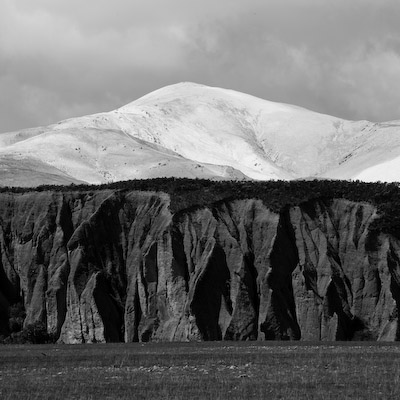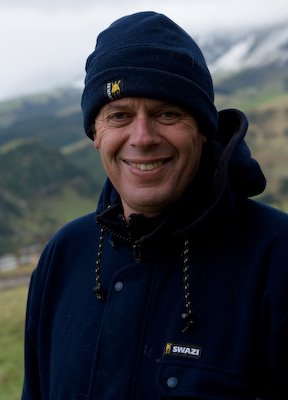Roadmarks

It is my intention…to present to the public, from time to time, my impressions of foreign lands, illustrated by photographic views -Francis Frith (1822-1898)
The physical object to me, is merely a stepping stone to an inner world where the object, with the help of subconscious drives and focused perceptions, becomes transmuted into a symbol whose life is beyond the life of objects we know and whose meaning is a truly human meaning - Clarence John Laughlin (1905-1985)
The storm sneaked into town around mid-morning on Wednesday behind the shirttails of the anticyclone that had been with us for a week now. It wasn't one of those summer storms, the ones that take a deep breath, draw themselves up to their full height, flex their biceps and tower imposingly before venting themselves. No, rather it was one of those furtive southerly storms that creep up on you, the sort where the first warning of its arrival is a tentative gust of wind and a few spots of rain. You look up somewhat surprised from your cappuccino, realise with a sinking feeling you're not dressed for it, and retreat for cover. Once it knows it has your attention, that you recognise it , it unloads itself upon you.
Within an hour the drops of rain head turned to sleet and then thickened out into softly drifting snow flakes. I retreated to my flat, wound up every heater I could find, and turned my back on it. Had it been one of those big-bosomed, buxom opera singer storms, I might have ventured out into it, to dance with that and the light. But it wasn't imposing, it was a Gollum storm, snivelling around in the background, causing trouble in a sneaky, underhanded sort of way. It didn't deserve to be noticed. Until the next morning.
All night it whined and wept, shook and wrestled with the town, doing its best to get under roofs and inside unwary spaces and looking to kick over anything not tied down. In the end, tired, I turned my light out and left it to its own devices, to do what it would. It didn't stay long; it wasn't a storm with guts, with any sort of perseverance. It soon tired of its spiteful game and went on its way.
I was out of bed and on the road early the next morning. I had to go down to town (in this case, a 1 1/2 hour trip to Dunedin) and then be back by midday, so I decided to leave my camera equipment behind. Big mistake. The air was settled and still, scrubbed squeaky-clean ,and the hills appeared as if they had been steadily closing in under cover of the storm. While my back had been turned, the rag-end of a spiteful winter had scattered itself across the hills along the horizon. The clearing cloud above the Kakanuis was still holding back the early morning sun but it was getting in nonetheless, along the gap above the Pig Root, and in the crawlspace above the Danseys Pass. For a moment or two, I wondered whether to go back for my cameras, then decided against it. I was running to a schedule and needed to get down to the coast. Perhaps later.
I got back around 2 p.m, and by now the snow was gone from the plains, retreating slowly back up the hill under the relentless thrust of the incoming warm front. I knew if I didn't get out amongst it, I would miss out on an opportunity to make something of the event that was moving on. I packed my equipment and headed east towards Kakanuis, knowing it was time to make their acquaintance.
Down towards Kyeburn then back up the Ridge Road towards Naseby, out towards the Danseys Pass. Then, on a whim, I decided to follow the somewhat tentative gravel road up towards the Kyeburn diggings. The road ahead obviously hadn't seen a grader in quite some time, and Hinemoa shivered and shook on its uneven surface. Ahead of me, off to the right, I saw the first of the clay cliffs that break so abruptly out of the landscape. Up behind them, the snowdraped Kakanuis shimmered and resonated in the early afternoon light. The contrast between the two were so visually surprising that I stopped to look, to take notes, to analyse. Like an insistent dog the scene was barking at me, demanding that I take notice, that I pay attention.
In the viewfinder the scene was even more surprising, and the results on my LCD only served to amplify and delineate what was in front of me. I must have made around 50 images working left to right, exploring, tuning, feeling my way to the Moment. And then it came.
My friend Freeman Patterson maintains that a great image has no less than two and no more than five significant compositional elements. I'm still thinking that one through. The iconoclast inside me, who rebels at any rule and looks for a way to beat it, feels that there may be a way round it. But I haven't found it yet. This image contains four distinct compositional elements, (if you include the gorse on top of the cliffs as part of the cliffs) ranging from the soft relatively featureless clouds at the top of the photograph to the textured grass along the bottom of the amateur. The smoothness of the snow-covered hills contrasts with the clay cliffs beneath. It's a composition that, 24 hours later, still satisfies me.
Over a glass of wine (or three), Freeman and I talked one night in Africa about how some images can be roadmarks, marker pegs like the small stone ones that used to line the Roman roads, that told you how far it was from and to the next town. These are points of significance, indicators on a journey. Londinium 24 miles (or whatever the Romans used to measure distance). From time to time, if we keep at it, we will all make roadmark images, photographs that tell us we've moved on, that we have come to a place we don't really recognise, and yet which we know is significant. Freeman maintains the subconscious is always three to five years ahead of the conscious, that the photographs we are making now are the result of a process that began that long ago.
I cannot help feeling that the image I made out on the Kyeburn Road is a Roadmark, a pointer to a process that has been underway for some time; that in some way it is trying to tell me something.
What that is I have no idea.
But it has my attention.


2 Comments:
Hi Tony,
A question for you.
Ive got my name on the list for one of the Freeman workshops next year. I was discussing this matter recently with some other photographers and an opinion was related that a lot of what Freeman discusses in his books (and I assume his workshops) is primarily about design rather than art.
Ive got some of his books ( I love them) and I can see where that viewpoint comes from.
So my question is - what is the difference between design and art? Does good art dequire good design? Is good design enough?..........
I havnt really got this completely sorted but my answer is that art also has passion or story (or both).
Looking at Roadmarks before I read your post and I thought "nicely balanced image. Interesting contrast between the snow and the almost summer baked grass in the foreground. Love the mono treatment." Technical/design thoughts??
(By the way Im more and more these days pushing the greyscale button in lightroom.)
.........Then I read your story!!!!
cool - your image tells it too
Ian
Hi Ian:
I think this one deserves more than a simple reply here. give me a day oe two to think it over, and I will put up a post.
thanks for the thorny question!
Post a Comment
<< Home